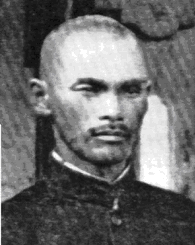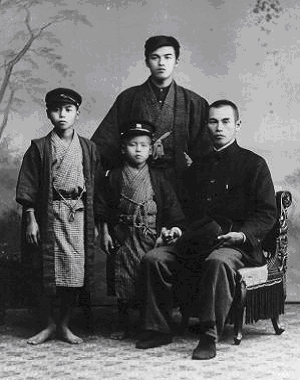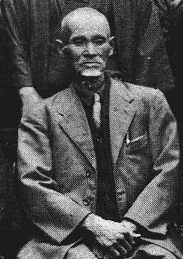Yabu was the eldest son on Yabu Kenden and Morinaga Shun. His father, Kenden was the third son in a family that could trace its position in the middle aristocracy (of Peichin rank)ii back to when records first began in 1689. Yabu's paternal grandfather, Kenyo, was the archery instructor for Lord Ikegusuku while his father, Kenten, was a court calligrapher. With such a pedigree and as the family's eldest male heir, Yabu had little difficulty getting not only a good education but gaining access to the best, if often secretive, teachers of the martial arts.
As a young man, Yabu was admitted as a student of the famous Matsumura Sokon, dubbed "Bushi" (or "warrior gentleman") by the King. By this time, Matsumura was an elderly gentleman, likely in his 70s or 80s, and most of the active instruction under his tutelage was actually undertaken by Itosu Yasutsune (1830-1915). Both Matsumura and Itosu were well known as tough teachers, demanding instructors in the perfection of kata, and no-nonsense tutors in the realities of self-defense and combative skills.
A tumultuous period
Yabu was raised during a tumultuous period in Okinawan history. Since the mid-1300s, Okinawa had close relations with the government of China, exchanging tribute and diplomatic missions frequently. Okinawan ships plied the oceans, trading from Southeast Asia to Korea. Okinawan merchants had extensive interests, and even permanent facilities, in Fujian province, just across the sea from the Ryukyu Islands of which Okinawa is the biggest. In 1689, however, the samurai of the Japanese Satsuma daimyo invaded Okinawa; from then until the mid-19th century they pulled the strings in the Okinawan Court while remaining only semi-visible. Thus Okinawa, its king and its royalty were caught between two masters. This situation changed radically in 1879 when the Japanese government openly annexed the Ryukyus, turning them into just another prefecture under the central government. Between then and the 1930s, the Japanese government attempted to force Japanese language and culture on the Okinawans and stamp out all vestiges of local culture, language, and thoughts of independence.
This must have been a very difficult and strange time for Okinawa's karate and kobudo masters. Karate and kobudo were integral parts of Ryukyuan culture and were intimately connected to Ryukyuan traditional dance, the Court and social structure, and loyalty to the royal family. Some refused to make the transition; others resisted. Funakoshi Gichin, for example, is often seen as one who embraced the change, read and spoke excellent standard Japanese, taught the Japanese curriculum as a teacher in Okinawa, and ultimately moved to Tokyo to spread karate broadly within Japanese society. But in his youth, Funakoshi refused to cut his traditional top-knot hair style as an act of defiance against Japanese hegemony, an act that cost him the opportunity to enter a mainland Japanese medical school.iii
Yabu's family, a mid-ranking aristocracy, must have been torn between loyalty to tradition and eschewing the opportunities afforded by joining mainstream Japanese society. One way into the mainstream was to join the military. I have seen conflicting opinions on whether Okinawans were subject to the military draft, but it appears that in any case Yabu Kentsu would have been exempt because he was married and had a child. Nonetheless, he decided to join the army in 1891 as Japan was beginning the militarism and expansionism that would lead to the Sino-Japanese War (1894-05), the Russo-Japanese War (1904-05), and finally the invasion of China (1932) and World War II (1941-45).
Yabu Takes "The King's Shilling"
Most Okinawans who were either drafted or attempted to join the military were rejected because the were too small, too weak, or in poor health. But when Yabu showed up for his physical, the doctors were amazed at his fitness and physique. His motives are unclear, but some speculate that in addition to wanting to test out his martial prowess, he wanted to prove that Okinawans were every bit as loyal and could be just as good as soldiers as any other "Japanese." According to some sources, because he was a volunteer, and possibly because of his marvelous physical capabilities, Yabu was immediately sent to a school for prospective noncommissioned officers. His age (25, probably considerably older than most recruits) may also have had to do with his being put on the "fast track." Traditionally, Okinawans were looked down upon as ignorant and fit only for "cannon fodder" as rank-and-file infantrymen, so Yabu must indeed have impressed his Japanese recruiters.iv

Yabu Kentsu in 1908

Yabu Kentsu in 1906 with his three sons, Kenden (18), with younger brothers Kenyu (left), and Kenshin (right).
Yabu returns to Okinawa
With the Sino-Japanese war over, Yabu was demobilized and returned to Okinawa. He entered Shuri's Prefectural Teacher's College where he both studied for a degree that would allow his employment as a teacher and helped Master Itosu try to convince the school system to require instruction in karate as part of the curriculum. Once the school system accepted karate as a regular course, Yabu helped the aging Itosu as his shihan-dai, doing most of the actual instruction. Although his own favorite kata was Gojushiho, he is remembered for drilling his charges endlessly in Naihanchi. Reportedly, Yabu said that students should do 10,000 repetitions of Naihanchi a year. The number 10,000 in China and Japan is often used to indicate a large number, but if taken literally, Yabu was calling on the students to repeat Naihanchi some 28 times per day! In any case, such statements indicate Yabu's serious mind set about karate training and his expectations of his students. Ever the soldier at heart, Yabu is often credited with introducing the militarized and organized method of teaching groups by mass commands, repeating basic techniques and the individual moves of kata by the numbers, rather than according to the individual's will as was the traditional way under most traditional teachers. Photos of Yabu (of which there are few) also show that from the time of his discharge, he kept the erect posture and extremely short haircut of a military "lifer."

Yabu Kentsu in 1927, long after his military career
With such a militaristic and patriotic mentality, one can only imagine Yabu's shock, disappointment, and anger when his eldest son and heir to a 200-year-old lineage announced that he had become a Christian. Yabu Kenden, under the influence of his cousin, who had already been baptized by a missionary, became a pacifist and vegetarian, rejecting the idea of military service. This apparently took place around or shortly after the time of the bloody Russo-Japanese War (1904-05). Father Kentsu was so angry he threatened to have his son drafted, causing the son to flee to Hawaii.vii After spending four years in Hawaii, Kenden moved to California, officially to study theology. Kenden's proclivities, however, ran toward a Tolstoyian interpretation of Christianity, i.e., one of self-perfection and rejection of organized religion, and eventually toward socialism. In Hawaii, he worked as an agricultural worker and became a gardener after moving to California, a common occupation for Japanese before World War II.
The breach between father, Kentsu, and son, Kenden, apparently was never healed. In 1919, Kenden married a Japanese woman, and in 1921 she became pregnant.viii Kentsu made his first civilian trip abroad in 1921-22 to visit his son, apparently to see what he expected would be a grandson and heir to the family lineage. Before his father's visit, Kenden reportedly asked his father not to "wear his sword" while visiting the U.S. (in other words, not to display his harsh and militaristic side and, presumably, to try to get along with his family). According to rumors, Kentsu intended to take the baby grandson back to Okinawa to have him raised "properly." Kentsu stayed only a short time. The baby turned out to be a girl, and Grandpa Yabu quickly departed, probably disgusted and disappointed. (The estrangement can clearly be seen in a photo taken of Kentsu, Kenden, and his wife, Mituye Joko.) He is not recorded as having either demonstrated nor taught karate during his brief stay.

Yabu Kentsu (left), Kenden (back) and Mitsuye, probably in 1921-22.
Yabu visited once again in 1927, apparently again hoping to witness the birth of a grandson and heir. Once again, he was to leave disappointed when another granddaughter arrived. Indicative of his cold feelings toward his "prodigal son," Yabu went from California to Hawaii where he stayed for almost nine months, teaching and promoting his style of karate among the large Okinawan disapora in the islands.
It is unclear whether Yabu kept in touch with his "American" son through letters, but it appears they had no further contact. There is no evidence the younger Yabu ever visited Okinawa and the old karate master and Gunso never returned to the U.S. Yabu Kentsu, one of Okinawa's most feared fighters, died in 1936 of tuberculosis.

Yabu Kentsu in 1936, about a year before his death from tuberculosis, obviously a shadow of his powerful former self.
- Most of Yabu Kentsu's life is well known and details are available in a wide variety of sources. Particularly valuable in preparing this article, however, was Joseph R. Svinth, "Karate Pioneer Kentsu Yabu, 1866-1937," in Journal of Combative Sport, June 2003, reprinted at http://ejmas.com/jcs/jscart-svinth.0603.htm. The linkage to Yabu's family troubles over religion, as far as this author knows, has only been revealed in Edward E. Bollinger, The Cross and the Floating Dragon: The Gospel in Ryukyu. Pasadena, CA: William Carey Library, 1983.
- For a description of the ranks in old Okinawan society, see Christopher M. Clarke, Seito: A Handbook for Students From Gokyu to Ikkyu. Huntingtown, MD, 2006, pages 148-149
- Funakoshi Gichin, Karate-do: My Way of Life. New York: Kodansha, 1975, pages 2-5. Funakoshi ultimately knuckled under and cut his hair to become a school teacher, an act that horrified his family.
- Other accounts indicate he entered as a private and was later promoted to sergeant. Given the relatively short time he was in the service, the above account seems to make more sense.
- For example, as reported in Richard Kim, Weaponless Warriors. Los Angeles, CA: Ohara Publications, 1974 and George Alexander, Okinawa: Island of Karate. Lake Worth, FL: Yamazato Publications, 1991.
- Despite this promotion, he was forevermore known in Okinawa as "Yabu Gunso" or Yabu the Sergeant as a term of respect and affection. He is widely remembered by many Okinawans even today.
- Bollinger, The Cross and the Floating Dragon, page 102-105.
- Kenden's official identification documents listed his last name as "Yabe," an alternative pronunciation then favored by Japanese officialdom. In 1910, he reportedly had his name legally changed from "Yabu" to "Yabe," a further indication of his estrangement from his family and culture.